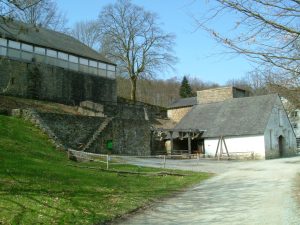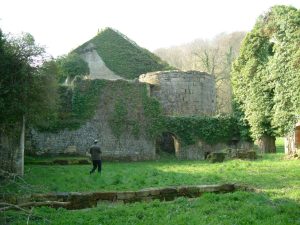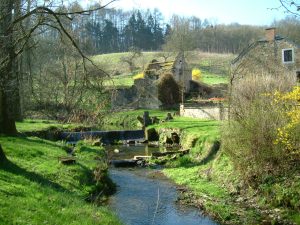In the evolution of iron making in Europe certain key developments seem to have occurred in Belgium during the later part of the Middle Ages. Initially in the basin of the River Meuse, but later over a wider part of southern Belgium, blast furnaces and forges were established and several areas of iron making grew and continued in use, in some cases, to the present day. With the growth of iron making in the Weald indirectly indebted to the developments that took place in Belgium, it seemed appropriate to visit some of the sites of ironmaking in that country.
Our first port of call was the Maison de la Métallurgie in Liège. Here, a late-17th century furnace and forge, from elsewhere in Belgium, have been reconstructed and surrounded by the tools used to operate them. A large number of iron products are also on display, including a substantial collection of firebacks.

Le Fourneau de St Michel lies about 5km north of St Hubert, in the Ardennes forest. The site includes a blast furnace built in the 18th century, a forge building, charcoal and ore stores, and an interesting museum containing models illustrating the iron making processes. A large number of iron products displayed there included, in particular, a range of iron stoves.
Further to the south, the Musée Gaumais at Virton contained a vast collection of firebacks, or taques de foyers. These were striking for their size, which was commonly in excess of a metre square, and for the quality of their designs. They dated from the late 16th to the mid 18th centuries.

Crossing into France, the furnace at Buré d’Orval, east of the village of Torgny, dated from the early 19th century but, because of the later industrialisation of the region compared to Britain, the works were in a rural location adjacent to the ironmaster’s house, much as Wealden works were. The furnace survives, as do the shells of several buildings.
Of mid-19th century date, all that remains of the furnace at Cons la Grandeville, west of Longwy, is the stack standing beside the local road. The development of furnace construction, which had been seen at Buré d’Orval, was even more evident here, with the traditional stone stack less functional and with access to the hearth on all four sides.

Evidence of the continuity of iron-making skills from Belgium to the Pays de Bray, in northern France, reveals that Henri le Feron built an iron mill at Le Becquet, near Beauvais, in 1451. Henri came from Jausse-les-Ferons near the village of Gêves, south east of Namur. The probable site of his forge at Jausse was located although nothing could be seen after an interval of over 550 years. The visit to Belgium was the second overseas trip made by the Group, the first being in 1989 to the Pays de Bray.
© Wealden Iron Research Group 2000-21.
